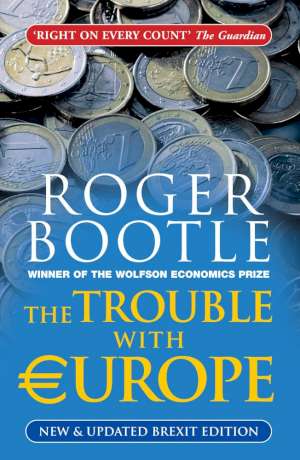24 June 2015
The Trouble with Europe
Roger Bootle
2015, Nicholas Brierley Publishing, 352 pages, £7.99
ISBN 9781857886306
Reviewer: Donald Anderson

Few subjects in political economy can be as fluid at present as that of the future of the EU and the UK’s membership. Any author attempting a book on the subject is faced with a constantly moving target, stabilised only by its foundations in recent history. Roger Bootle’s The Trouble with Europe was first published in 2014. It has now been updated, and it is a credit to the original that despite being written before the outcome of the UK General election, and hence before the certainty of a referendum on UK membership, and while the Greek crisis was still germinating, it has held up well.
Bootle’s objective is to analyse why the EU is not working, how it can be reformed, and – with an implicit expectation of failure – what might ensue. The book is accordingly divided into three distinct parts.
The first deals in some detail with the background and structure of the present EU, how it has evolved institutionally, how it has functioned in practice, and how this has eroded its popularity among its citizens. Repeatedly, Bootle emphasises its aspirational importance to the founding members in the aftermath of the Second World War.
It is a competent overview. However, given Bootle’s later criticisms, these chapters would benefit from an explanation of why the essentially French model of administrative structure was adopted, and analysis of the effect subsequent constitutional developments may be having on the management of the EU in its now much expanded form. A summary of the critical treaties, particularly Maastricht, Nice and Lisbon, would also be helpful, as would an exploration of the conflicting merits of the ‘deeper versus wider’ visions of the EU’s future, since the UK’s successful advocacy of EU eastward expansion remains a source of bitterness.
The heart of Bootle’s theme, however, lies in the second section, which examines the economic performance of the EU before and after the creation of the eurozone, and looks at the disadvantages inherent in the latter. As one would expect from the author, the account of the euro’s problems is lucid, comprehensive and readable. The discussion of the non-financial aspects of economic policy is less certain. Competition and trade policy are dealt with only briefly, and state aid policy, one of the EU’s most sophisticated and an essential pillar of the Single Market, is not covered at all. These omissions unbalance the narrative and this may be why a number of the conclusions Bootle reaches to explain the EU’s poor economic performance read unconvincingly. That said, his suggestion for policies that might rectify the shortcomings (“prevent an economic disaster”) are well developed and objective. They also contain some pertinent observations, notably on financial regulation and on Germany.
These shortcomings apart, the first two sections provide a comprehensive basis for the third, the most readable and interesting, in which the future of the EU is creatively discussed. Here, Bootle speculates widely, alternative scenarios ranging from the eurozone splitting into two (north and south), to its complete break up, and in all cases, the UK’s exit. He expresses the hope that the EU will reform, but clearly thinks it will not and will in consequence collapse. In the book’s context it is a logical conclusion, but in reaching it he substantially overestimates the influence of the continental anti-EU movements.
Noting Europe’s declining relevance, his alternatives for the UK include joining NAFTA and the creation of a new trading bloc with the Commonwealth countries, some of which he observes correctly have considerable growth potential. Although he greatly underestimates the dangers attending such restructuring, and the risks inherent in the geopolitical turbulence which would certainly ensue, the options are thought provoking. Perhaps they should provide the basis for a third edition next year.
